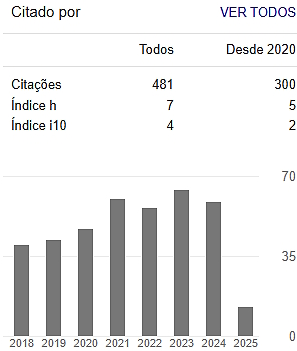ESTUDO DO COMPORTAMENTO DINÂMICO DO MODELO NEURONAL DE HINDMARSH-ROSE
Palavras-chave:
Modelo de Hindmarsh-Rose; Dinâmica Neuronal; Estabilidade.Resumo
Baseado no modelo neuronal de Hindmarsh-Rose (HR) para transmissão de impulsos nervosos, este trabalho visa estudar propriedades e o comportamento dinâmico do sistema caótico não linear que descreve o bursting neuronal em um único neurônio. Por parte da bioengenharia, existe grande motivação no estudo do modelo HR pelo fato de ser bem representativo ao neurônio biológico, podendo, assim, simular vários comportamentos de um neurônio real, dentre eles, o comportamento periódico, aperiódico e caótico. A literatura sugere que o comportamento caótico represente no ser humano o estado epilético ou convulsivo. Através de simulações computacionais, considerando os parâmetros do sistema, foi analisado que a estabilidade é altamente sensível as condições iniciais e produzindo oscilações, mais ainda, quando a oscilação aumenta o comportamento aleatório tende a aumentar tornando o sistema imprevisível.
Downloads
Referências
da SILVA, F. H. L. et al. Dynamical diseases of brain systems: different routes to epileptic seizures. IEEE transactions on biomedical engineering, v. 50, n.5, p. 540-548, 2003. https://doi.org/10.1109/TBME.2003.810703
FITZHUGH, Richard. Impulses and physiological states in theoretical models of nerve membrane. Biophysical journal, v. 1, n. 6, p. 445-466, 1961. https://doi.org/10.1016/S0006-3495(61)86902-6
HINDMARSCH, J. L.; ROSE, R. A model of neuronal bursting using three coupled first order differential equations. Proc. R. Soc. Lond. B, The Royal Society, v. 221, n. 1222, p. 87–102, 1984. https://doi.org/10.1098/rspb.1984.0024
HODGKIN, A. L.; HUXLEY, A. F. A quantitative description of membrane current and its application to conduction and excitation in nerve. The Journal of physiology, v. 117, n. 4, p. 500–544, 1952. https://doi.org/10.1113/jphysiol.1952.sp004764
JR BUTERA, R. J.; RINZEL, J.; SMITH, J. C. Models of respiratory rhythm generation in thepre-botzinger complex. I. Bursting pacemaker neurons. Journal of neurophysiology, American Physiological Society Bethesda, v. 82, n. 1, p. 382–397, 1999. https://doi.org/10.1152/jn.1999.82.1.382
MILAN, P.; et al. Synchronization and information flow in EEGs of epileptic patients. IEEE Engineering in Medicine and Biology Magazine, v. 20, n.5, p. 65-71, 2001. https://doi.org/10.1109/51.956821
MONTEIRO, L. H. A. Sistemas Dinâmicos. São Paulo, Brasil, Editora Livraria da Física, 2002.
NAGUMO, Jinichi; ARIMOTO, Suguru; YOSHIZAWA, Shuji. An active pulse transmission line simulating nerve axon. Proceedings of the IRE, v. 50, n. 10, p. 2061-2070, 1962. https://doi.org/10.1109/JRPROC.1962.288235
RUGGIERO, M. A. R.; LOPES, V. L. R. Cálculo Numérico. Aspectos teóricos e computacionais. 2 ed., Editora Pearson. 1996.
SAVI, M. A. Dinâmica Não-Linear e Caos, Editora e-papers. 2006.
WOLF, A.; SWIFT, J. B.; SWINNEY, H. L.; VASTANO, J. A. Determining Lyapunov Exponents from a Time Series, Physica, v. 16D, p. 285-317, 1985. https://doi.org/10.1016/0167-2789(85)90011-9

